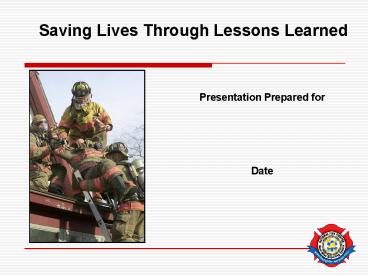Presentation Prepared for - PowerPoint PPT Presentation
1 / 37
Title:
Presentation Prepared for
Description:
Members of the fire service community are learning from other ... Fire service community will receive bulletins, program ... Spell Check. Optional ... – PowerPoint PPT presentation
Number of Views:34
Avg rating:3.0/5.0
Title: Presentation Prepared for
1
Saving Lives Through Lessons Learned
Presentation Prepared for
Date
2
Why Study Near Misses?
1 Tragic Opportunity to learn
1 Serious Accident
300 Survival Stories Opportunities to learn
15 Major Accidents
300 Near Misses
15,000 Observed Worker Errors
3
Program Overview
- Voluntary
- Confidential
- Non-punitive
- Secure
- Web based
- Free
4
All Hazards Reporting System
No statute of limitations on reporting. Reports
reviewed and coded by fire service professionals.
5
Definition of a Near Miss
- unintentional, unsafe occurrence.
- could have resulted in an injury, fatality or
property damage. - Only a fortunate break in the chain of events
prevented an injury, fatality or property damage.
6
Near Miss Sometimes spectacular
7
sometimes mundane
8
Program Goals
- Prevent injuries and protect the lives of other
firefighters by providing a central repository
for lessons learned. - Collect information which can assist in
formulating strategies to reduce the number of
firefighter injuries and fatalities. - Foster a safety-focused culture that recognizes
errors as aninherent part of human behavior.
9
Why Share Near-Miss Experiences?
- To share lessons learned with firefighters on a
national scale. - To prevent another firefighterfrom getting
injured or killed. - To identify patterns ininjury-producing
behaviors. - Aviation industry found that sharing near-misses
improved overall safety.
10
What is being done with the collected information?
- Members of the fire service community are
learning from other firefighters. - Officers are using reports in training drills.
- Fire service community will receive bulletins,
program reports and alerts depending on the
urgency of the information collected. - Training academies are incorporating near-miss
reports in building curriculum. - Fire service associations are using reports as
part of an improved emphasis on safety to their
members. - Manufacturers will be notified when reports are
received regarding performance issueswith
equipment.
11
Program Development
- Focus groups helped develop the reporting form
and the Web site. - 38 departments beta tested the Web site from May
thru August 2005. - Web site launched nationally at Fire-Rescue
International in August 2005. - Averaging 40 reports submitted per month.
- Multiple confirmed changes of practice recorded.
12
Home Page Screen
13
Resources Page
14
Demographics Questions
Seven questions about the reporter (title, years
of fire service experience, department type, etc.)
15
Event Questions
Eight questions about the event (type, cause,
etc.)
16
Event Description
Describe the event in your own words.
Use the memory joggers for help
17
Lessons Learned
Describe the lessons learned.
18
Spell Check
19
Optional Contact Information
Providing your name and contact information is
optional. Reports can be submitted anonymously
without contact information.
20
Post Submission Screen
Once a report is submitted, the reporter can view
a list of reports similar to his/her report.
21
Search Reports Screen
Search reports submitted from others.
22
Sub-Event Type Keyword Search
23
Keyword Search
24
Near-Miss Report Trail
Step 1 Firefighter submits report
Step 5 Fire service reads and learns from
near-miss experiences
Step 4 Report is posted (Original report
destroyed)
- Step 2
- Reviewer 1
- Reads report
- De-identifies report
- Codes report
- Sends to Reviewer 2
- Step 3
- Reviewer 2
- Reads report
- Returns for posting
25
Department Type
2006
2007
26
Event Type
2006
2007
27
Contributing Factors
August 2007
28
Job or Rank
August 2007
29
Age at Time of Event
August 2007
30
Experience at Time of Event
August 2007
31
Reflex Time-Event to Report
August 2007
32
Get involved
- Encourage your members to file reports. Even if
the event occurred in the past, a firefighter can
benefit. - Add www.firefighternearmiss.com to your
organizations website. - Promote use of the system through communications
to your members. - Contact nearmiss_at_iafc.org for materials and
strategies to get your members interested in
near-miss reporting.
33
For more information
- Visit www.firefighternearmiss.com.
- Read the FAQ section.
- Use the Contact Us on the Home Page
- Call the Near-Miss Office Project Managers
- Amy Hultman, 703-273-9815, x364
- John Tippett, 703-273-9815, x367
- To receive a Report of the Week via e-mail,
please e-mail nearmiss_at_iafc.org with the word
Subscribe in the subject line.
34
Program Support
- This project is funded by a grant from the
Department of Homeland Securitys Assistance to
Firefighters Grant Program. - The Firemans Fund Insurance Company provided
matching funds for 2004 and 2005. - The project is supported by Chief Billy
Goldfeder of FirefighterCloseCalls.com in mutual
dedication for firefighter safety and survival.
35
- The project is administered by the International
Association of Fire Chiefs (IAFC) in consultation
with the National Fire Fighter Near-Miss
Reporting System Task Force. The project is
endorsed by IAFC, International Association of
Fire Fighters and the Volunteer Combination
Officers Section of the IAFC.
36
- If we continue on the current LODD/injury path,
the fire service will experience 1000 fatalities
and 1,000,000 injuries in the next ten years. - If not now, when?
- If not us, who?
37
- Questions?































